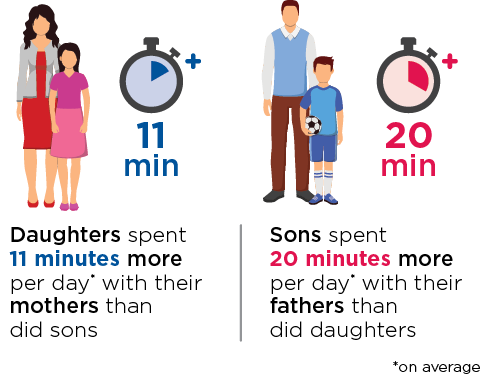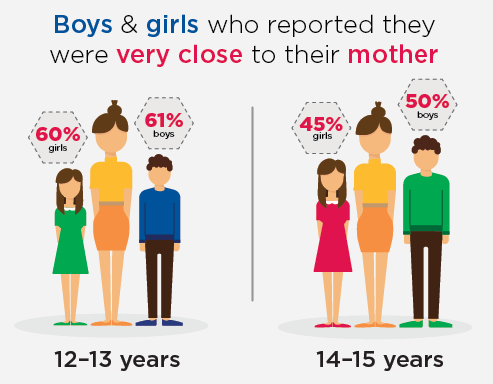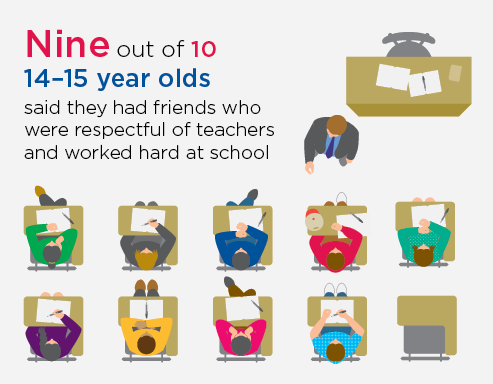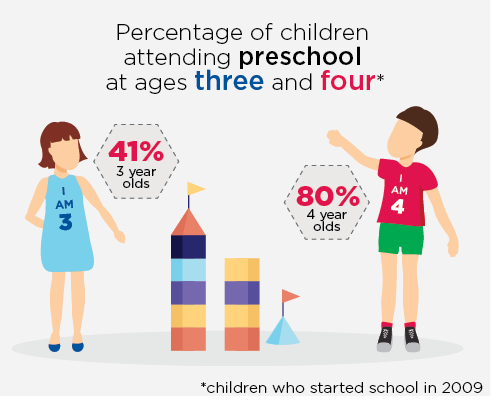2. Key findings
2. Key findings

Children's housing experiences
- Higher density housing, such as apartments and townhouses, now makes up a quarter of Australian housing. From age 4-5 onwards, nine out of 10 LSAC study children were living in a separate (detached) house.
- One in five study children were living in a home that their parents were renting; and around three out of five were living in a home that their parents had purchased and were paying off with a mortgage.

Housing affordability stress
In 2014, around one-third of families with children living in private rental accommodation were experiencing housing affordability stress, compared to less than one in 10 families with children who were paying off a mortgage.
For some families, the experience of housing affordability stress was a result of parental separation - over 40% of children who had moved house around the time of their parents' separation moved into a situation of housing affordability stress.
For most children, living in a household experiencing housing affordability stress was a temporary situation. However, more than a quarter of children who had remained in a single-parent household for two consecutive waves of LSAC also remained in a situation of housing affordability stress.
Who do adolescents spend their time with?
- As children entered adolescence, they spent less time with their parents and more time alone.
- This increase in 'alone time' was partly related to teens staying up late, but also to them spending more time alone throughout the day.
- Across all age groups:
- Children spent more time with their mother than their father.
- Girls spent more time with their mother than boys did.
- Boys spent more time with their father than girls did.
- Regardless of whether children were living in a two-parent or a single-parent family, the total amount of time that children spent with their parents was roughly the same. However, children in single-parent families spent very little time with both parents together.

Teens want to be alone
As children get older there is a significant increase in the time they spend alone. On average, 10-11 year olds spent 3.5 hours alone on weekdays and 4.5 hours alone on weekends. At age 14-15, the average amount of time spent alone was 4.7 hours per day on weekdays and 6.3 hours per day on weekends.
This increase in alone time was greater for boys than girls.
Relationships between parents and young teens
- Most young people said that they felt close to their mother and father but:
- At age 12-13, around 60% of boys and girls said that they were very close to their mother. By age 14-15, these figures dropped to 50% of boys and 45% of girls.
- At age 14-15, 47% of boys - and only 35% of girls - said that they were very close to their father.
- Reports of mother-child conflict were more common than reports of father-child conflict. Even so, teens were more likely to go to their mother if they had a problem, rather than their father.
- Compared to girls who lived with their biological father, girls who had a step-father reported less positive (step)father-daughter relationships. This was not the case with boys.

Conflict between parents and teens
While 20-30% of parents said that they sometimes disagreed and fought with their child, approximately 5% said that arguments with their child had led to them staying angry with each other for a very long time, or that they had refused to talk to their child after an argument.
Reports of the study child stomping out of the house after an argument were more common among parents of girls - one in four mothers of 14-15 year old girls, and one in five mothers of 14-15 year old boys, said that their child sometimes stomped out of the house after an argument.
Adolescents' relationships with their peers
- At age 12-13 and 14-15, approximately 85% of young people reported having friends who respected their feelings, listened to them and who they trusted.
- Nine out of 10 14-15 year olds said they had friends who were respectful of teachers and worked hard at school.
- More than two in five 14-15 year olds said that their friends disliked school, around one in five said that their friends put popularity above grades, and one in 10 girls and one in six boys said that their friends got into trouble at school.
- Around one in ten 14-15 year olds said that at least some of their friends had engaged in risky behaviours such as trying drugs, smoking cigarettes, drinking alcohol, breaking the law or getting into fights.

Bullying among teens
One in five 14-15 year olds reported being the victim of bullying in the past month. However, fewer than one in 10 (7%) admitted to being a bully.
Having friends with high levels of moral behaviour or a positive attitude towards school was associated with a lower likelihood of being a victim of bullying.
Having friends who engaged in more risky behaviours increased the likelihood of being bullied, and also of being a bully.
Adolescent help-seeking
- Around 97% of young people aged 14-15 said that they had sought help for a personal or emotional problem in the past 12 months; and 92% said they would seek help if they had a problem in the future.
- Family and friends were the most common sources of help for 14-15 year olds, but around one in 10 had sought help from a mental health professional, and one in five had used the internet to source help.
- As children got older, fewer sought help from their parents - nine out of 10 sought help from their parents at age 10-11, seven out of 10 at age 14-15.
- Teens with higher levels of self-perceived social support from friends and family were more likely to say they would be willing to seek help in the future than those with inadequate social support.

Help from friends
There were some gender differences in adolescent help-seeking. Among 14-15 year olds, more boys than girls said they would seek help from parents and teachers, while more girls than boys would seek help from friends.
Preschool and children's readiness for school
Ready for school?
Among children who started school in 2009, around one in four boys, but only one in 10 girls, were considered developmentally vulnerable in at least one of the five domains measured by the Australian Early Development Census:
- physical health and wellbeing
- social competence
- emotional maturity
- language and cognitive skills
- communication skills and general knowledge.
- Children who had not been to preschool, kindergarten or long day care at ages three or four had the highest risk of developmental vulnerability when they started school.
- Compared to children who had attended two years of preschool, for children who had not attended preschool or long day care at ages three or four:
- the odds of being at risk of vulnerability in the areas of physical health and wellbeing, communication skills and general knowledge were doubled
- the odds of being at risk of vulnerability in the area of language and cognition were tripled.
- For children who attended long day care at age three and then preschool at age four, the odds of being at risk of vulnerability in the area of language and cognition were 1.5 times higher than those for children who had attended preschool at ages three and four.

Kids' care and activities before and after school
- At age 6-7, almost one in five children went to a formal outside-school-hours care program, compared to one in 10 children at age 10-11.
- Most primary school children (83% of 6-7 year olds and 90% of children aged 8-9 and 10-11) participated in at least one regular extracurricular activity such as sports, art, music or performance classes.
- Compared to children at independent schools, children at government schools were more likely to attend outside-school-hours care programs and less likely to participate in extracurricular activities provided by the school.
- Children in schools with a lower level of educational advantage were less likely to attend outside-school-hours care or participate in extracurricular activities.

Informal care
Informal outside-school-hours care was more frequently used than formal care, with almost one in four children in informal care either before or after school.
Across all ages, grandparents were the most common providers of informal before or after school care, with 13-14% of children being cared for by their grandparents. A smaller proportion of children were cared for by people other than their grandparents. The type of informal care varied according to the child's age. For example, around 5% of 10-11 year olds, but less than 2% of 6-7 year olds, were cared for by a sibling under the age of 18.
Use of technology in the classroom
- In primary school classrooms, computers were most commonly used to develop skills in specific academic areas, such as literacy, maths or science.
- In secondary school English classrooms, technology was regularly used to practise basic skills, prepare written text and correspond with others.

Schools and technology
High school English teachers generally had positive views about the use of educational technology in their school - more than four out of five teachers said that their school administration viewed educational technology as a priority and that teachers were interested in integrating ICT into their teaching.
However, around a quarter of secondary school teachers said that the ICT infrastructure and technical support at their school was inadequate.
Eating problems in mid-adolescence
- At age 14-15:
- 3% of girls and 1% of boys met diagnostic criteria for either anorexia nervosa or bulimia nervosa.
- One in two girls and one in five boys said that they had been afraid of gaining weight in the last four weeks.
- Two out of three girls said they would be at least a little concerned, and one in seven said they would be really upset, if they gained one or two kilograms. By contrast, one in two boys said it would not bother them, and one in seven boys said they would be pleased.

Dieting among teens
One in four girls and one in 10 boys consciously restricted their food intake to control their weight.
Among 14-15 year olds who engaged in some form of dieting, around two-thirds of girls and almost half of boys were in the normal weight range. This suggests that most teens diet to either maintain a healthy weight or achieve the thinner body shape typically idealised in Australian society.
Compared to adolescents who were not dieting, those who were restricting their food intake reported:
- more emotional problems
- lower levels of school adjustment
- more social difficulties.
Children's use of health care services
- The use of health care services changed as children got older. For example, the percentage of children who had seen a GP in the past 12 months decreased as they got older, but the percentage who had been to the dentist increased.
- The percentage of children who needed medical attention due to injury also increased as children got older; and the types of injuries changed. In the early years of childhood, cuts and scrapes were the most common injuries requiring medical attention, but in the teenage years, sprains and strains, fractures and broken bones were more common.
- For teenage boys, concussions were also an issue of concern - around 5,000 15-year-old boys across Australia required medical attention for an internal head injury or concussion in 2014.
Accessing health care
Around one in 10 parents reported having difficulties accessing health care services for their children, with reports of access difficulties more common among families with low incomes, those living in regional and remote areas, and those who speak a language other than English.
For example, compared to children living in major cities, the odds of having seen a GP in the past 12 months were halved for children and adolescents in regional and remote areas.

Acknowledgements
Featured image: © GettyImages/kate_sept2004










